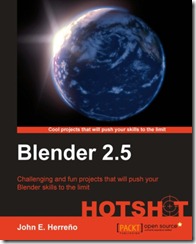 John E. Herreño is an Electronics Engineer from the National University of Colombia. He got interest in open source software and how much it can help in the development of countries. He works doing Drupal web development and Blender training, and develops custom software. You can visit his site at http://jeh3.net
John E. Herreño is an Electronics Engineer from the National University of Colombia. He got interest in open source software and how much it can help in the development of countries. He works doing Drupal web development and Blender training, and develops custom software. You can visit his site at http://jeh3.net
He is the author of the book, "Blender 2.5 HOTSHOT", which consists in 10 chapters that contain 10 projects. These projects are very similar to the situations you meet in real life projects, and are the kind of things that someone who employs or commissions you may ask you.
In real life projects, people ask you to make a final image, model something specific, and things like that. This book covers different projects from beginning to end.
The first project consists in making a render of a sci-fi space scene. This is what a pure 3D artist does at his work, creating a model from scratch, a background, adding effects, and rendering the piece, obtaining a final image that accomplishes the idea in his mind.
The second project, "Fly a Fighter Aircraft Through a Storm", is for creating a war aircraft that flies through some clouds. In this lesson you learn modeling tips, the use of shaders to increase realism of 3D models, with textures and material settings combined, cloud effects with particles, and of course, you learn to animate the flying machine.
This project illustrates the workflow of a 3D animator, whose task is to produce animated films by making 3D models, creating a world around them, and taking them to life by adding movement through time.
The use of blueprints is common in technical 3D modeling of vehicles and industry pieces, for example. In project 3, you learn how to put these skills in practice. A blueprint is a image in a sheet that contains views of an object from the most common angles (top, side, back, bottom, front...). From this blueprint you can model adding increasing complexity and using techniques toold in this project. Finally, you will create a car paint shader.
Notice how in all these projects, the final product of your work is obtained. The author doesn't stops until the final result is obtained, so you can see how real proffessionals work.
In "Create a Professional Looking Demo Reel" you produce something that is often required for most 3D portfolio, and it's a demo reel that showcases your skills as 3D modeler, made using the video sequencer of Blender.
Now that you have become familiar with the video sequencer, it comes the time to learn some of the game engine. As you know, Blender includes a 3D game engine which is very powerful and has been used in multiple commercial and indy games.
In project 5 you learn the basics of this engine using the Python programming language, to build an interactive walkthrough around a building in a 3D environment that uses a skybox, a semisphere with a sky painted on it. This gives you the opportunity to learn how to bake textures in Blender, and also learn simple UV mapping.
Interactive walkthrough are a classic in animation, showcases of virtual reality, and even on intro sequences of games.
On the following chapter, "Detailed Render of the Earth from Space", you'll focus on pre-processing of textures and post-processing of a render. These are all techniques aimed to get the maximum quality for your renders using Blender 3D.
Project 7 is about animating an humanoid character. The book explains later, on chapter 10, how was this humanoid modeled, but the author prefers to explain how to animate it now, because as you have already read the chapters about animation, it's easy for you to understand all this now, without losing the perspective of an animator.
To animate this humanoid figure, you'll be told how to create a skeleton, an armature for the body, with its joints and limits, that can be later animated and deform the humanoid as it walks in an animation.
Humanoid animations have particularities and are the base of many projects in the films and animation industry.
"Create a Snail" is the eighth chapter. It's a journey through the process of creating an organic creature by using both parametric and box modeling techniques. The shape of the snail is also refined using the sculpt tools of Blender, wich are very powerful for artistic modeling and digital sculpture. It also introduces you to the creation of organic shaders and the use of subsurface scattering to simulate beings that have flesh (human or not).
One of the fields in which 3D modeling was widely used from the beginning is architectural modeling and visualization. Chapter 9 is about architectural rendering, in the example of a kitchen. It is also an introduction to lighting, as it's the 50% or more of a good render.
Last but not least, project 10 is about modeling humanoids, by combining the speed of box modeling techniques with the power of Blender's sculpt tools.
To summarize, as you can notice, this is a book that really gives examples of tasks that a pro 3D modeler has to do when he/she is hired by someone. A book from a get-things-done perspective. It is a very good learning material for someone who uses Blender and needs to have a perspective on how the different pieces fit.
When we learn to use a program, we usually learn how to model something, then we see another example on the internet on how to map your UVs, later another piece of the puzzle, another different example on how to make a shader, and so on and on. This book is different because it tells you how to build the whole puzzle. It tells you how to achieve projects from beginning to end, explaining it all with the same project, in a logical ad real-life way: you model something, then texture this same thing, then animate it, and so on, and get a real animation video. Or model something, apply shaders, light it, and render and get a real render.
And the author makes this with 10 example projects carefully chosen to showcase the typical situation for someone who wants to learn to achive the most common uses of 3D.
Get it at Packt Publishing, you won't repent:
Blender 2.5 HOTSHOT, by John E. Herreño
© by Jordi R. Cardona. Link to this post without copying the text.
If you liked this post, get updates of Hiperia3D News for FREE






 Hiperia3D News is a Netbeans Community Partner, in recognition for developing the
Hiperia3D News is a Netbeans Community Partner, in recognition for developing the 


1 comments
This is one great program for people at car detailers perth. It may be able to provide a general preview of how a car will look like after the painting job is over.
Post a Comment